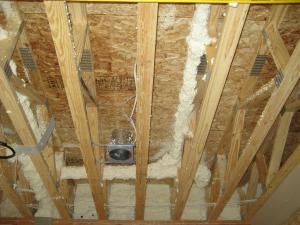Our Insulation Company receives a lot of phone calls from homeowners asking about adding additional insulation to their attics. As we spend time on the phone, they initially think they want to add foam insulation to their attics and crawl spaces as a way to lower their utility bills. Lowering a utility bill by adding more insulation to your attic, basement walls and crawl spaces is the way to reduce energy bills, but using foam insulation to do it may not be the best solution to your inadequate insulation and here is why.
Fact: Foam insulation is Dangerous to Install
Installing foam insulation is definitely a job for professionals. Due to the nature of the application and the chemicals involved, protective gear in the form of haz- mat suits, eye protection and a mask is worn. In its chemical state, spray foam’s part A and B can be toxic to sensitive individuals. Once the product is cured, the product is deemed ‘inert’. Most experts agree that homeowners should not be in for home 7-72 hours after a spray foam installation to avoid any sensitivity that may exist. Proper ventilation in the attic is key to avoiding any and all sensitivities associated with foam. Proper ventilation in your attic will also draw fresh air into the attic, increasing the R-Value of your insulation and saving you money every month. Improper and inexperienced mixing of chemicals can result in the foam pulling away from the walls and studs. Although much of the space between the studs may still be insulated, any gaps in the insulation create heat loss or gain and that means higher utility bills.
Foam insulation needs to be expertly applied to be effective
Closed cell foam insulation does not expand into the framing cavity the way open cell foam insulation does. Making sure the installation is the proper thickness in the walls and in the roof line to meet the energy codes may be more difficult with closed cell foam insulation . Installers need to spot check to tell if there was 100% coverage with closed cell foam insulation applications. On the flip side, spraying too much insulation is much more expensive. You may see this as a result of an installer who didn’t know where the conditioned and the unconditioned space of the attic as so they erred on the side of caution and covered walls that may not have needed it and wasted money for the homeowner. The application has to be the same thickness throughout the space as heat and cold will find its way to the under-insulated areas of the attic. One of the best reasons to use foam insulation is the air-sealing ability it possesses. But it can’t seal places where it’s not sprayed. An indicator that the insulation in the attic is ineffective is if the attic temperature in the summer is hot and the rest of your house is cool. The opposite is true for cold in the winter.
If done improperly, foam insulation is difficult to remove.
Once professionally and expertly applied, spray foam lasts a lifetime. Improperly mixing chemicals or not applying it uniformly in the attic may require a homeowner to undertake the difficult job of removing it. You can remove it by carefully not cutting any electrical wiring, while using a reciprocating saw or spray foam knife to cut up along the inside of the wall frame board then cut across the foam to the other side, down the inside of the board and up the last side. Insert a crow bar into the foam and pull out the square. This may take several attempts before you free the foam from the studs. Be careful not to damage the wall board with your cuts and tools. An uneven application will make this task even more difficult as a feel for the depth of the hardened foam can never be relied upon. You may use a metal scraper to remove the remaining bits of foam. Do not apply heat, thinners, acetone or chemicals to the hardened foam as this is hazardous and could pose a fire risk.
The most cost effective and reliable way to get a professional application and to fully understand the pros, cons and benefits of any insulation type and application, is to hire an insulation contractor who has years of experience in the industry and has a solid reputation among home owners and home builders in your area. You can’t afford to make a bad decision. It may not only be costly to your wallet but it could be harmful to your health.








All I read these days seems to say that foam insulation is the way to go. I feel certain that homes and businesses that use it will benefit for years to come on energy bills. Thanks for the great information!